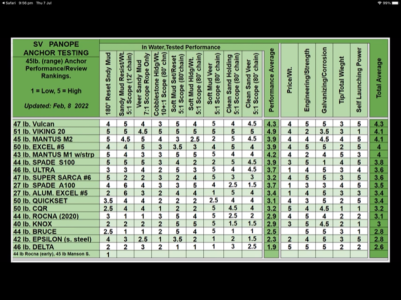down...2 greens
Member
Dangerous territory I know, but I was hoping for some advice and/or information on the subject of the A-word...
It's for a 34ft AWB of about 5T displacement and a fair bit of windage (high topsides and cockpit enclosure). I'm minded to go Epsilon, but should it be 10 or 16 Kg? The sizing guide at
https://dkutenx65dka0.cloudfront.net/cms/PDFs/841284841285SIZING.pdf
seems a bit vague. I have an electric windlass and 8 mm chain so the only real downside of the larger version is the extra 6 Kg on the bow - irrelevant in practical terms?
I also see from the Lewmar website that only stainless models (with associated comedy price tags) seem to be currently available. Some retailers still seem to have galvanised ones in stock so I think I could track one down, but maybe there's a reason why they have apparently been discontinued?
And finally - I can only find a sizing template for the 6 Kg model on the website - if anyone happens to know where I could find a 10/16 Kg one that would be very handy.
Thanks in advance!
It's for a 34ft AWB of about 5T displacement and a fair bit of windage (high topsides and cockpit enclosure). I'm minded to go Epsilon, but should it be 10 or 16 Kg? The sizing guide at
https://dkutenx65dka0.cloudfront.net/cms/PDFs/841284841285SIZING.pdf
seems a bit vague. I have an electric windlass and 8 mm chain so the only real downside of the larger version is the extra 6 Kg on the bow - irrelevant in practical terms?
I also see from the Lewmar website that only stainless models (with associated comedy price tags) seem to be currently available. Some retailers still seem to have galvanised ones in stock so I think I could track one down, but maybe there's a reason why they have apparently been discontinued?
And finally - I can only find a sizing template for the 6 Kg model on the website - if anyone happens to know where I could find a 10/16 Kg one that would be very handy.
Thanks in advance!

